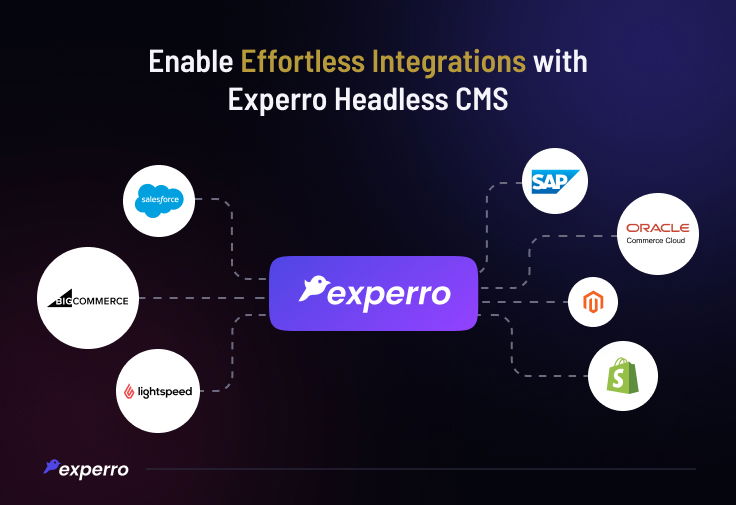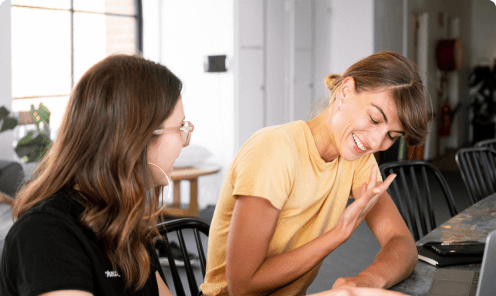Top Benefits of Headless CMS in 2024

What’s Inside
- Pros and Cons of Headless CMS
Real-Life Use Cases or Applications of Headless CMS- Who Needs a Headless CMS
- How to Choose a Headless CMS
- Conclusion
Key Takeaways
- Traditional CMS solutions (Legacy CMS) have customization, scalability, and readiness limitations.
- Separation of content and presentation layer is one of the best Headless CMS benefits. This provides flexibility and scalability for businesses to manage content across channels.
- Experro's user-friendly headless CMS solution helps businesses to easily manage new and published content, optimize digital presence, and offer seamless digital experiences to customers.
Step right up to the digital age, where Headless CMS is the star of the show! 🌟
Imagine unleashing your content across the web and beyond, without a single hiccup, thanks to the myriad Headless CMS benefits at your fingertips.
With the power of Headless CMS, you're not just keeping up; you're setting the pace.
Flexibility? Check. Lightning speed? You bet. Scalability? Like never before.
These are just a few of the standout benefits Headless CMS brings to the table.
Get ready to be wowed as we dive into the world where your content is free to soar, no strings attached.
Welcome to the revolution of Headless CMS, where every digital experience is tailor-made for success, powered by the unparalleled benefits of going headless. 🚀
Pros and Cons of Headless CMS
Exploring the Headless CMS pros and cons reveals a comprehensive view of how this modern approach to content management can transform digital strategies, while also presenting certain challenges that organizations need to navigate.
Advantages of Headless CMS
Looking at the headless CMS benefits reveals how its flexibility and efficiency can significantly enhance digital content strategies.
1. Content Centralization:
Challenge: Traditional CMS architecture often ties content to specific presentation layers, making it difficult to update or repurpose content across different platforms without duplicating efforts.
Headless CMS Solution: By storing all content in a central repository, Headless CMS decouples content from presentation, allowing for a single source of truth.
This approach simplifies content management, updates, and tracking, ensuring consistency and integrity across various channels and devices.
2. Personalization and Targeting:
Challenge: Delivering personalized content to diverse user segments can be cumbersome with a traditional CMS due to its rigid content delivery structure.
Headless CMS Solution: Headless CMS's API-driven nature facilitates integration with analytics and marketing tools, enabling dynamic content personalization.
Businesses can leverage these capabilities to tailor content for different user segments, significantly enhancing user engagement and conversion rates.
3. Future-Proof Technology:
Challenge: Adapting content strategies to new technologies and platforms can be a daunting task with traditional CMS, often requiring significant redevelopment.
Headless CMS Solution: Headless CMS offers a flexible, API-driven approach that allows businesses to easily extend content delivery to emerging channels and devices.
This adaptability ensures that the content strategy remains sustainable and relevant, without the need for a complete CMS overhaul.
4. Scalable Architecture:
Challenge: Scaling content delivery to meet growing traffic demands and expanding content strategies can strain the resources and infrastructure of traditional CMS.
Headless CMS Solution: Designed with scalability in mind, Headless CMS can efficiently manage increased traffic and content loads.
Its architecture supports business growth, ensuring high performance and reliability even as demands on the system grow.
5. Cost-Effective:
Challenge: Traditional CMS often incurs high development and maintenance costs, especially when customizing content delivery for each platform.
Headless CMS Solution: By separating the frontend from the backend, Headless CMS reduces the need for platform-specific development, leading to significant cost savings over time.
Businesses benefit from lower development and maintenance expenses, making Headless CMS a more cost-effective solution in the long run.
6. Global Reach with Multilingual Support:
Challenge: Traditional CMS systems struggle with managing content in multiple languages, often requiring separate instances for each language, complicating content synchronization and updates.
Headless CMS Solution: Headless CMS simplifies multilingual content management by supporting various languages and locales within the same system.
This streamlines the creation and publishing process for global content, enabling businesses to effectively reach a worldwide audience without the complexities of traditional systems.
7. Speed to Market:
Challenge: In conventional setups, the dependency between front-end and back-end development can slow down the process of getting digital products to the market due to sequential development cycles.
Headless CMS Solution: The decoupled nature of Headless CMS provides the best of both worlds, allowing organizations to select the most suitable approach for their needs—be it a traditional, headless, or a hybrid CMS model—thus offering a versatile solution that caters to various business needs.
8. Developer Support and Speed:
Challenge: Traditional CMS platforms can limit developers with proprietary technologies and inflexible frameworks, hindering development speed and innovation.
Headless CMS Solution: Platforms like Experro equip developers with robust API support and the freedom to use their preferred tools, significantly enhancing development speed and efficiency.
This flexibility enables quicker project completion and fosters innovation, showcasing the significant advantages of headless CMS.
9. Cost Efficiency and Future-Proofing:
Challenge: Initial investments in CMS can be high, with added costs for updates and re-platforming to accommodate future needs.
Headless CMS Solution: Headless CMS allows organizations to start with what they need and scale over time, reducing upfront costs.
Headless architecture supports easy updates and integration with new technologies, ensuring the digital presence remains current with minimal additional investment.
10. Superior Software Architecture:
Challenge: Monolithic CMS architectures can become unwieldy over time, leading to increased security vulnerabilities and maintenance challenges.
Headless CMS Solution: Headless CMS offers a more streamlined and secure architecture by separating content management from the delivery layer, enhancing the overall security and maintainability of web platforms.
11. Efficient Third-Party Integrations:
Challenge: Integrating third-party services and tools can be complex and insecure with traditional CMS, often requiring custom development.
Headless CMS Solution: Headless CMS simplifies the integration of external services through APIs, enabling secure and efficient content sharing and collaboration without heavy reliance on IT.
12. Adaptable Design:
Challenge: Updating the design or user interface with traditional CMS can be a slow and rigid process, often impacting the content layer.
Headless CMS Solution: With Headless CMS, the design can be updated independently of the content, providing the agility to adapt to design trends and user expectations without affecting the underlying content management.
13. Unified Content Hub:
Challenge: Managing content across various platforms can lead to inconsistencies and duplication, complicating content strategy.
Headless CMS Solution: Headless CMS centralizes content in a single hub, making it reusable and easily manageable across platforms, thereby supporting a cohesive content strategy.
14. Collaborative Workflows:
Challenge: Collaborative content creation and management can be hindered by the linear and rigid workflows of traditional CMS.
Headless CMS Solution: The separation of concerns in Headless CMS fosters more dynamic and flexible workflows, enabling content teams and developers to collaborate effectively without stepping on each other's toes, speeding up content delivery.
15. Flexibility for Marketers:
Challenge: Marketers often rely on developers to make even minor updates in traditional CMS setups, slowing down content updates.
Headless CMS Solution: Headless CMS empowers marketers with complete control over content creation and publication, reducing dependency on developers for updates and changes, thus speeding up marketing initiatives.
16. SEO Friendly:
Challenge: Optimizing content for search engines can be cumbersome in traditional CMS due to the intertwined nature of content and presentation layers, limiting control over SEO-critical elements.
Headless CMS Solution: Headless CMS offers greater control over content delivery, including SEO aspects like structured data, URLs, and meta tags, independent of the presentation layer.
This separation allows for more targeted SEO strategies and ensures that content is optimized for search engines, enhancing visibility and search rankings.
In short, choosing Headless CMS means getting ready to offer amazing digital experiences that truly connect with people everywhere, leveraging the advantages of a headless CMS for innovative content delivery across multiple channels and digital platforms.
Disadvantages of Headless CMS
Considering the disadvantages of Headless CMS highlights the challenges and limitations that come with this innovative approach to content management.
1. Lesser Options to Set Merchandising Rules:
Headless CMS often offers fewer out-of-the-box solutions for complex merchandising rules, necessitating custom development for specific e-commerce needs.
2. Limited Built-in Features:
Headless CMS may lack built-in features like themes, plugins, or WYSIWYG editors, requiring additional development for such functionalities, contrasting with the more feature-rich traditional CMS platforms.
3. Increased Development Time:
Without a predefined frontend, developers must build presentation layers from scratch, potentially increasing project timelines and costs, a departure from traditional CMS architectures where the frontend is more tightly integrated.
Real-Life Use Cases or Applications of Headless CMS

From powering dynamic e-commerce platforms to streamlining content for mobile applications, its applications are as diverse as they are impactful.
Let's explore some of the real-life application Headless CMS use cases is making a significant difference.
1. Digital Publishing:
Media outlets and publishers harness the advantages of Headless CMS to manage and distribute content across multiple platforms, ensuring timely and synchronized content delivery.
2. Educational Platforms and E-Learning:
Headless CMS benefits educational institutions by providing a consistent learning experience across devices and learning management systems, allowing for a consistent learning experience regardless of the student's device or location.
3. Corporate Websites:
Businesses can utilize Headless CMS to maintain their corporate websites, ensuring that company news, investor information, and career opportunities are easily updated and consistently presented across different regions and languages.
4. Marketing Campaigns and Microsites:
Marketing teams leverage the flexibility of Headless CMS to deploy campaign-specific microsites and landing pages, integrating them with various marketing tools and platforms for a unified and effective campaign execution.
5. Event Management:
For conferences, concerts, and other events, a Headless CMS can manage event schedules, speaker information, and ticketing across official websites, mobile apps, and digital displays, providing attendees with real-time updates and information.
6. Healthcare Platforms:
Healthcare providers can employ Headless CMS to disseminate health information, updates, and patient resources across websites, patient portals, and mobile apps, ensuring that critical health information is accessible and consistent across all touchpoints.
7. Government and Public Services:
Government agencies can use Headless CMS to manage and deliver public service information, emergency updates, and community resources across websites, mobile applications, and public kiosks, improving citizen access to vital information.
8. Real Estate Portals:
Real estate agencies can utilize Headless CMS to manage property listings, photos, and virtual tours, ensuring that potential buyers have access to up-to-date and consistent property information across various platforms.
9. Sports and Entertainment:
Sports leagues and entertainment venues can use Headless CMS to deliver schedules, player information, and event content across official websites, mobile apps, and in-venue screens, enhancing the fan experience.
Who Needs a Headless CMS
Headless CMS serves various departments within an organization by catering to their unique needs and workflows:
1. For Marketers:
Headless CMS enables seamless omnichannel content delivery, rapid content updates without developer dependency, and advanced personalization, thereby enhancing customer engagement and conversion rates.
2. For Developers:
It offers technology flexibility, simplifies system integrations with APIs, and improves security by decoupling the content delivery layer from content management, addressing common development challenges.
3. For Content Creators:
The platform facilitates streamlined content creation and efficient management through a user-friendly interface, focusing solely on content without the complexities of presentation details.
4. For IT and Operations:
Headless CMS supports scalability to meet growing business needs and reduces maintenance overhead by allowing backend updates without disrupting the frontend.
5. For Product Managers:
It enables rapid prototyping and cross-platform product development, ensuring faster product launches and support for a wide range of devices and platforms.
6. For Customer Experience Teams:
The separation of content from presentation allows for optimized, personalized user experiences across all touchpoints and ensures consistent content and messaging across digital channel.
Headless CMS presents a solution that not only addresses specific departmental needs but also enhances overall organizational efficiency and market responsiveness.
How to Choose a Headless CMS

Choosing the right Headless CMS for your organization involves considering several key factors to ensure it aligns with your specific needs and goals.
1. Business Needs and Objectives:
Understand what your organization aims to achieve with the Headless CMS.
This includes the type of content you'll manage, the channels and devices you want to publish to, and the roles of your team members in the content management process.
2. Content Architecture and API Design:
A well-designed content architecture and robust API are crucial.
They should allow for efficient content management, easy integration with various frontend systems, and support for features like ordering, filtering, and pagination.
3. Media Management Capabilities:
Opt for a CMS that offers advanced tools for organizing, categorizing, tagging, and searching images and videos.
This will help in optimizing content delivery across different devices and enhancing user experience.
4. Developer and Authoring Experience:
Ensure the CMS provides a seamless experience for both developers and content creators.
Developers should have access to comprehensive documentation, SDKs, and support for their preferred technologies, while content creators should find the CMS intuitive and easy to use for daily tasks.
5. Workflows and Collaboration:
Evaluate the CMS's support for workflows, authoring roles, and collaboration features.
As your team grows, having distinct roles and permissions becomes essential for efficient content management.
6. Composability and Content Modeling:
The CMS should offer flexibility in content modeling, allowing for the creative construction of content structures.
Check if it supports a variety of meta fields and content relationships for streamlined content reusability.
7. Performance and Scalability:
Content delivery performance is key. Look for features like caching, API management, and global CDN support to ensure fast and reliable content distribution.
8. Security, Compliance, and Privacy:
Ensure the CMS has robust security measures in place to protect sensitive data and comply with regulatory requirements.
This includes features like backups, infrastructure security, and privacy controls.
9. Support and Community:
Good support from the CMS provider and an active community can be invaluable, especially when facing challenges during implementation or seeking new features.
10. Cost and ROI Considerations:
Assess the initial setup costs, ongoing expenses, and the potential return on investment.
A CMS that balances these costs while delivering efficient content management can offer long-term value.
Conclusion
Headless CMS is changing the game for businesses, making it easier and more efficient to manage and share content.
It's not just about keeping up with the latest digital trends; it's about leading the way. With features like better flexibility, faster speeds, and the ability to share content everywhere, businesses can create unique online experiences on different platforms.
Whether it's for websites, online stores, or digital magazines, Headless CMS helps make sure content looks good and works well everywhere.
It's great for marketers who need to get new promotions out quickly, developers who want to use their favorite tools, and content creators who need an easy way to organize their work.
Thinking about switching to Headless CMS means looking at how it can help achieve bigger goals, drive creativity, and grow the business.
In short, choosing Headless CMS means getting ready to offer amazing digital experiences that truly connect with people everywhere.
FAQs


Ekta Ganwani
20 June 2024With a sharp knowledge of SEO and SERP, Ekta's research is her strength. She is a meticulous researcher with an eagle eye for finding errors and ensuring on-page content is top-notch. When not working, Ekta can be found binging the latest Netflix series or meditating to find her inner zen.